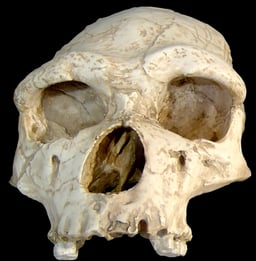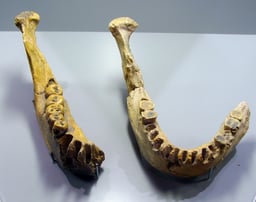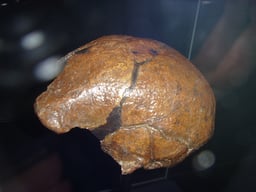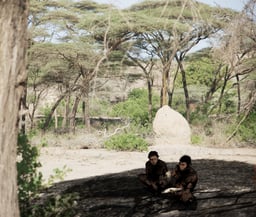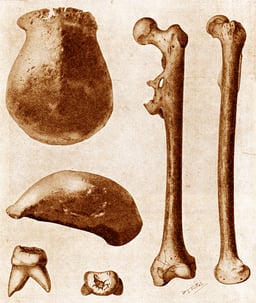Homo erectus

Homo erectus

| Homo erectus | |
|---|---|
| Reconstructed skeleton of Tautavel Man[2] | |
| Scientific classification | |
| Kingdom: | Animalia |
| Phylum: | Chordata |
| Class: | Mammalia |
| Order: | Primates |
| Suborder: | Haplorhini |
| Infraorder: | Simiiformes |
| Family: | Hominidae |
| Subfamily: | Homininae |
| Tribe: | Hominini |
| Genus: | Homo |
| Species: | H. erectus |
| Binomial name | |
| Homo erectus (Dubois, 1893) | |
| Synonyms | |
| |

Forensic reconstruction of an adult female Homo erectus.[3]

Forensic reconstruction of an adult male Homo erectus.[4]
Homo erectus (meaning 'upright man') is a species of archaic humans that lived throughout most of the Pleistocene geological epoch. Early fossil evidence for homo erectus was discovered with specimens dating from roughly 1.8 million years ago (discovered 1991 in Dmanisi, Georgia),[5] in Hubei, China (min 2.15 Ma)[6], and 2.1 million years ago (discovered 2018 in the Loess Plateau, China).[7]
H. erectus has been hypothesized as a direct ancestor of the later hominins including Homo heidelbergensis, Homo antecessor, Homo neanderthalensis, Homo denisova, and Homo sapiens.[8]
A debate regarding the classification, ancestry, and progeny of H. erectus, especially in relation to Homo ergaster, is ongoing, with two major positions:
- H. erectus is the same species as African H. ergaster; or,
- it is in fact an
Some paleoanthropologists consider H. ergaster to be a variety, that is, the "African" variety, of H. erectus; the labels "Homo erectus sensu stricto" (strict sense) for the Asian species and "Homo erectus sensu lato" (broad sense) have been offered for the greater species comprising both Asian and African populations.[11][12]
H. erectus eventually became extinct throughout its range in Africa, Europe and Asia, but developed into derived species, notably Homo heidelbergensis. As a chronospecies, the time of its disappearance is thus a matter of contention. The species name proposed in 1950 defines Java Man as the type specimen (now H. e. erectus). Since then, there has been a trend in palaeoanthropology of reducing the number of proposed species of Homo, to the point where H. erectus includes all early (Lower Paleolithic) forms of Homo sufficiently derived from H. habilis and distinct from early H. heidelbergensis (in Africa also known as H. rhodesiensis).[13] In this wider sense, H. erectus had mostly been replaced by H. heidelbergensis by about 300,000 years ago, with possible late survival of H. erectus soloensis in Java as late as 70,000 years ago,[1] or up to 550,000 years ago.[14][15]
The discovery of the morphologically divergent Dmanisi skull 5 in 2013 has reinforced the trend of subsuming fossils formerly given separate species names under H. erectus considered as a wide-ranging, polymorphous species.[16] Thus, H. ergaster is now well within the accepted morphological range of H. erectus, and it has been suggested that even H. rudolfensis and H. habilis (alternatively suggested as late forms of Australopithecus rather than early Homo) should be considered early varieties of H. erectus.[17][18]
| Homo erectus | |
|---|---|
| Reconstructed skeleton of Tautavel Man[2] | |
| Scientific classification | |
| Kingdom: | Animalia |
| Phylum: | Chordata |
| Class: | Mammalia |
| Order: | Primates |
| Suborder: | Haplorhini |
| Infraorder: | Simiiformes |
| Family: | Hominidae |
| Subfamily: | Homininae |
| Tribe: | Hominini |
| Genus: | Homo |
| Species: | H. erectus |
| Binomial name | |
| Homo erectus (Dubois, 1893) | |
| Synonyms | |
| |
Discovery and type specimen

Poster of Homo georgicus. National Archaeological Museum of Spain.
The Dutch anatomist Eugène Dubois, inspired by Darwin's theory of evolution as it applied to humanity, set out in 1886 for Asia (despite Darwin's theory of African origin) to find a human ancestor. In 1891–92, his team discovered first a tooth, then a skullcap, and finally a femur of a human fossil on the island of Java, Dutch East Indies (now Indonesia). Excavated from the bank of the Solo River at Trinil, in East Java, he first (1893) allocated the material to a genus of fossil chimpanzees as Anthropopithecus erectus, then the following year assigned his species to a new genus as Pithecanthropus erectus (the genus name had been coined by Ernst Haeckel in 1868 for the hypothetical link between humans and fossil Apes)—from the Greek πίθηκος (píthēkos, "ape") and ἄνθρωπος (ánthrōpos, "human")—based on the proposal that the femur suggested that the creature had been bipedal, like Homo sapiens.
Dubois' 1891 find was the first fossil of a Homo-species (or any hominin species) found as result of a directed expedition and search (the first recognized human fossil had been the circumstantial discovery of Homo neanderthalensis in 1856; see List of human evolution fossils). The Java fossil from Indonesia aroused much public interest. It was dubbed by the popular press as Java Man; but few scientists accepted Dubois' argument that his fossil was the transitional form—the so-called "missing link"—between humans and nonhuman apes.[19]
Most of the spectacular discoveries of H. erectus next took place at the Zhoukoudian Project, now known as the Peking Man site, in Zhoukoudian, China. This site was first discovered by Johan Gunnar Andersson in 1921[20] and was first excavated in 1921, and produced two human teeth.[21] Davidson Black's initial description (1921) of a lower molar as belonging to a previously unknown species (which he named Sinanthropus pekinensis)[22] prompted widely publicized interest. Extensive excavations followed, which altogether uncovered 200 human fossils from more than 40 individuals including five nearly complete skullcaps.[23] Franz Weidenreich provided much of the detailed description of this material in several monographs published in the journal Palaeontologica Sinica (Series D).
Nearly all of the original specimens were lost during World War II during an attempt to smuggle them out of China for safekeeping; however, authentic casts were made by Weidenreich, which exist at the American Museum of Natural History in New York City and at the Institute of Vertebrate Paleontology and Paleoanthropology in Beijing, and are considered to be reliable evidence.
Similarities between Java Man and Peking Man led Ernst Mayr to rename both Homo erectus in 1950.
Throughout much of the 20th century, anthropologists debated the role of H. erectus in human evolution. Early in the century, due in part to the discoveries at Java and Zhoukoudian, the belief that modern humans first evolved in Asia was widely accepted. A few naturalists—Charles Darwin most prominent among them—theorized that humans' earliest ancestors were African: Darwin pointed out that chimpanzees and gorillas, humans' closest relatives, evolved and exist only in Africa.[24]
Origin and dispersal
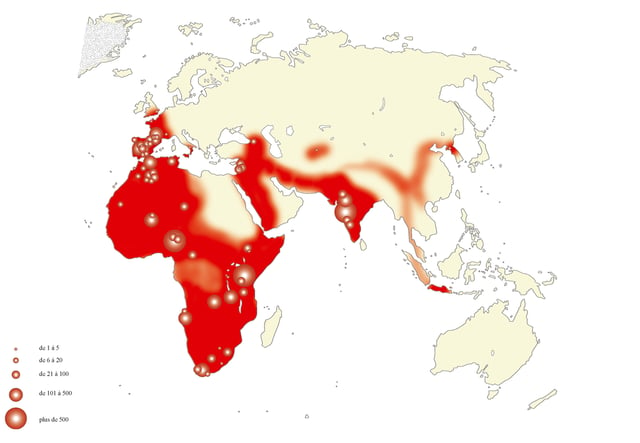
Map of the distribution of Middle Pleistocene (Acheulean) cleaver finds
The derivation of the genus Homo from Australopithecina took place in East Africa after 3 million years ago. The inclusion of species dated to just before 2 million years ago, Homo habilis and Homo rudolfensis, into Homo is somewhat contentious.[25] Especially as H. habilis appears to have coexisted with H. ergaster/erectus for a substantial period after 2 Mya, it has been proposed that ergaster may not be directly derived from habilis.[26]
Homo erectus emerged about 2 million years ago. Fossils dated close to 1.8 million years ago have been found both in Africa and in West Asia, so it is unclear whether H. erectus emerged in Africa or in Asia. Ferring et al. (2011) suggest that it was still H. habilis which reached West Asia, and that early H. erectus developed there. Early H. erectus would then have dispersed from West Asia, to East Asia (Peking Man) Southeast Asia (Java Man), back to Africa (Homo ergaster), and to Europe (Tautavel Man).[27][28]
Africa
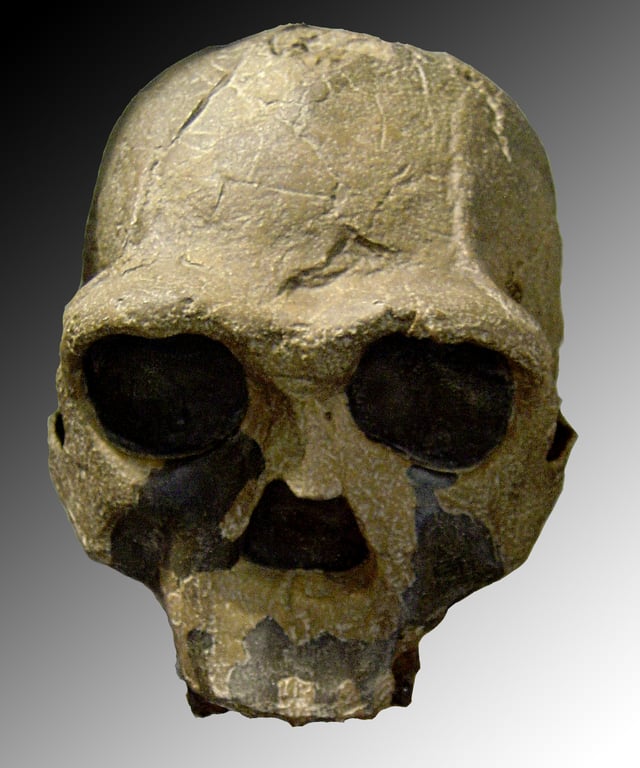
KNM-ER 3733 (1.6 Mya, discovered 1975 at Koobi Fora, Kenya)
In the 1950s, archaeologists John T. Robinson and Robert Broom named Telanthropus capensis;[29] Robinson had discovered a jaw fragment in 1949 in Swartkrans, South Africa. Later, Simonetta proposed to re-designate it to Homo erectus, and Robinson agreed.[30]
From the 1950s forward, numerous finds in East Africa suggested sympatric coexistence for H. ergaster and H. habilis for several hundred millennia, which tends to confirm the hypothesis that they represent separate lineages from a common ancestor; that is, the ancestral relationship between them was not anagenetic, but was cladogenetic, which here suggests that a subgroup population of H. habilis—or of a common ancestor of H. habilis and H. ergaster/erectus—became reproductively isolated from the main-group population, eventually evolving into the new species Homo ergaster (Homo erectus sensu lato).[31]
In 1961, Yves Coppens discovered a skull in northern Chad. He coined the name Tchadanthropus uxoris for what he considered the earliest fossil human discovered in north Africa.[32] Although once considered to be a specimen of H. habilis,[33] T. uxoris has been subsumed into H. erectus but it is no longer considered a valid taxon.[32][34] It was reported that the fossil "had been so eroded by wind-blown sand that it mimicked the appearance of an australopith, a primitive type of hominid".[35] It is probably only 10,000 years old according to stratigraphy, paleontology and C14 dating presented in Michel Servant's PhD as early as 1973.[36]
Eurasia
Caucasus
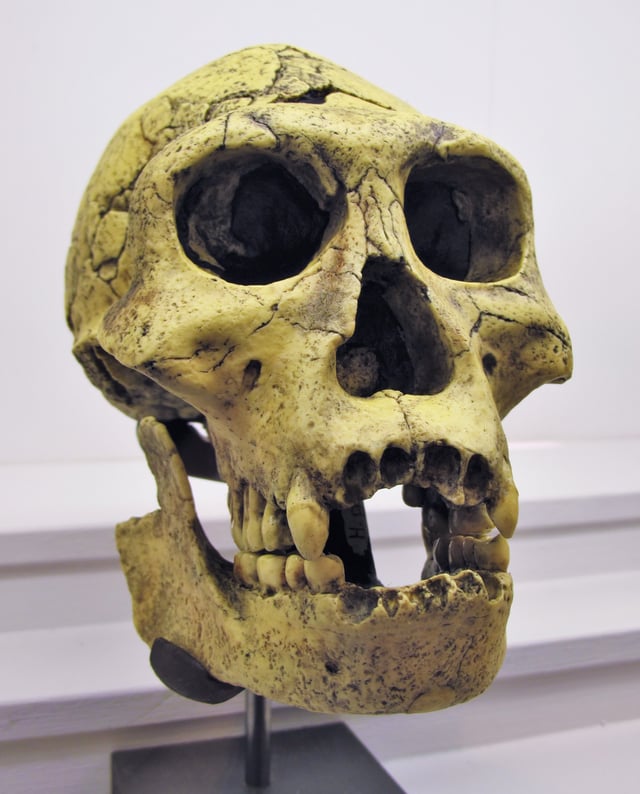
Dmanisi skull 3 (fossils skull D2700 and jaw D2735, two of several found in Dmanisi in the Georgian Transcaucasus)

Reconstruction of Homo georgicus based on D2700, by Élisabeth Daynès, Museo de la Evolución Humana, Burgos, Spain.
Homo erectus georgicus is the subspecies name assigned to fossil skulls and jaws found in Dmanisi, Georgia. First proposed as a separate species, it is now classified within H. erectus.[37][38][39] The site was discovered in 1991 by Georgian scientist David Lordkipanidze. Five skulls were excavated from 1991 forward, including a "very complete" skull in 2005. Excavations at Dmanisi have yielded 73 stone tools for cutting and chopping and 34 bone fragments from unidentified fauna.[40]
After their initial assessment, some scientists were persuaded to name the Dmanisi find as a new species, Homo georgicus, which they posited as a descendant of African Homo habilis and an ancestor to Asian Homo erectus. This classification, however, was not supported, and the fossil was instead designated a divergent subgroup of Homo erectus.[41][42][43][44]
The fossil skeletons present a species primitive in its skull and upper body but with relatively advanced spine and lower limbs, implying greater mobility than the previous morphology.[45] It is now thought not to be a separate species, but to represent a stage soon after the transition between H. habilis to H. erectus; it has been dated at 1.8 Mya.[38][46] The assemblage includes one of the largest Pleistocene Homo mandibles (D2600), one of the smallest Lower Pleistocene mandibles (D211), a nearly complete sub-adult (D2735), and a toothless specimen D3444/D3900.[47]
Two of the skulls—D2700, with a brain volume of 600 cubic centimetres (37 cu in), and D4500 or Dmanisi Skull 5, with a brain volume of about 546 centimetres—present the two smallest and most primitive Hominina skulls from the Pleistocene period.[17] The variation in these skulls were compared to variations in modern humans and within a sample group of chimpanzees. The researchers found that, despite appearances, the variations in the Dmanisi skulls were no greater than those seen among modern people and among chimpanzees. These findings suggest that previous fossil finds that were classified as different species on the basis of the large morphological variation among them—including Homo rudolfensis, Homo gautengensis, H. ergaster, and potentially even H. habilis—should perhaps be re-classified to the same lineage as Homo erectus.[48]
East and Southeast Asia
Meganthropus refers to a group of fossils found in Java, dated to between 1.4 and 0.9 Mya, which are tentatively grouped with H. erectus, at least in the wider sense of the term in which "all earlier Homo populations that are sufficiently derived from African early Homo belong to H. erectus",[13] although older literature has placed the fossils outside of Homo altogether.[51]
Java Man (H. e. erectus, the type specimen for H. erectus), discovered on the island of Java in 1891/2, is dated to 1.0–0.7 Mya. Lantian Man (H. e. lantianensis), discovered in 1963 in Lantian County, Shaanxi province, China, is roughly contemporary with Java Man.
Peking Man (H. e. pekinensis), discovered in 1923–27 at Zhoukoudian (Chou K'ou-tien) near Beijing, China, dates to about 0.75 Mya.[52] and a new 26Al/10Be dating suggests they are in the range of 680,000–780,000 years old.[53][54] Yuanmou Man (H. e. yuanmouensis), discovered in Yuanmou County in Yunnan, China, in 1965, is likely of similar age as Peking Man (but with dates proposed as early as 1.7 Mya).[55]
Solo Man (H. e. soloensis), discovered between 1931/1933 along the Solo River, Java, is of uncertain age, dated between 0.25 and 0.075 Mya (the younger date would qualify Solo Man as the latest fossil still classified as H. erectus, even though it shows some derived features, notably larger cranial capacity).[58]
Europe
It is conventional to label European archaic humans contemporary with late H. erectus under the separate species name of Homo heidelbergensis, the immediate predecessor of Homo neanderthalensis. H. heidelbergensis fossils are recorded from 600 ka (Mauer 1 mandible), the oldest complete skulls are "Tautavel Man" (Homo erectus tautavelensis), c. 450 ka, and the Atapuerca skull ("Miguelón"), c. 430 ka. The oldest known human fossils found in Europe is a molar from the Sima del Elefante site, Atapuerca Mountains, Spain, dated c. 1.2 Mya. This is associated with the skull fragments of the "Boy of Gran Dolina" found nearby, dated 0.9 Mya and classified as Homo antecessor by the discoverers. The relationship of these fossils to H. erectus is open to debate, as no complete skull has been found. H. e. bilzingslebenensis (Vlcek 1978) refers to skull fragments found at the Bilzingsleben site, Thuringia, Germany.
There is, however, indirect evidence of human presence in Europe as early as 1.6 Mya, in the form of stone tools discovered at Lézignan-la-Cèbe, France, in 2008.[59] Other stone tools found in France and thought to predate 1 Mya are from Chilhac, Haute-Loire) and from the Grotte du Vallonnet, near Menton. Human presence in Great Britain close to 1 Mya is established by stone tools and fossilized footprints found near Happisburgh, Norfolk.[60][61]
Taxonomy

An alternate model proposed by Reed, et al., redrawn from Stringer.[63] Note the depiction of Homo ergaster as an ancestor of Homo erectus.

One proposed model of the evolution of several species of genus Homo over the last 2 million years (vertical axis) based on Stringer (2012).[62]
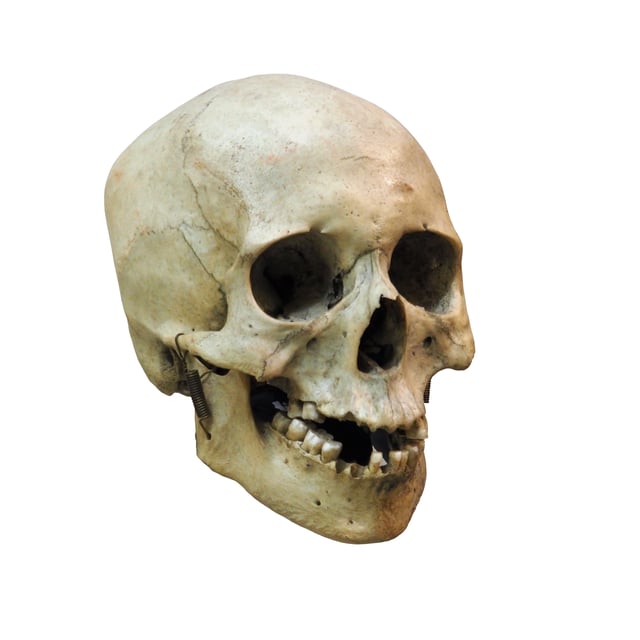
The skull of Homo sapiens, with its smaller teeth.
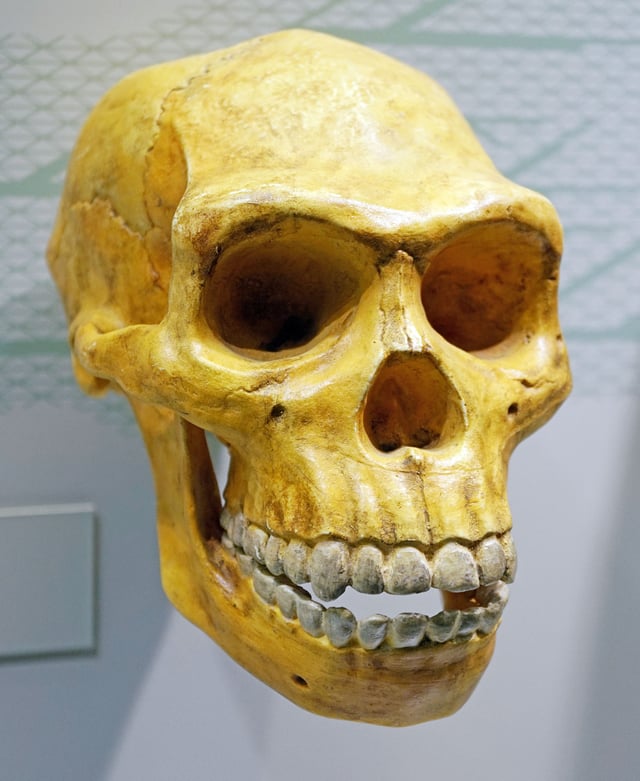
The skull of Homo erectus; note the large teeth.

Diagram of modern human shoulder bones.
Paleoanthropologists continue to debate the classification of Homo erectus and Homo ergaster as separate species. One school of thought calls H. ergaster the direct African ancestor of H. erectus, proposing that erectus emigrated out of Africa to Asia while branching into a distinct species.[64] Some scholars dispense with the species name ergaster, making no distinction between such fossils as the Turkana Boy and Peking Man. Still, "Homo ergaster" has gained some acceptance as a valid taxon, and the two species are still usually defined as distinct African and Asian populations of the greater species H. erectus, that is, "Homo erectus sensu lato".
One of the features distinguishing H. erectus from H. sapiens is the size difference in teeth. H. erectus has large teeth while H. sapiens have smaller teeth.[65] One theory for the reason of H. erectus having larger teeth is because of the requirements for eating raw meat instead of cooked meat like H. sapiens.
Some have insisted that Ernst Mayr's biological species definition cannot be used to test the above hypotheses—that is, that the two species might be considered the same. Alternatively, the amount of variation of cranial morphology between known specimens of H. erectus and H. ergaster can be compared to the same variation within an appropriate population of living primates (that is, one of similar geographical distribution or close evolutionary relationship), such that: if the amount of variation between H. erectus and H. ergaster is greater than that within an appropriately selected population, for example, say, macaques, then H. erectus and H. ergaster may be considered as two different species.
Finding an extant (i.e., living) model suitable for field study, analysis, and comparison is very important; and selecting a living sample population of an appropriate species can be difficult. (For example, the morphological variation among the global population of H. sapiens is small,[66] so our own species diversity may not be a trustworthy comparison. Fossils found in Dmanisi, Georgia were originally designated as a separate (but closely related) species, but subsequent specimens showed their variation to be within the range of Homo erectus.; they are now classified as Homo erectus georgicus. New foot tracks found in 2009 in Kenya and reported in Science by Matthew Bennett of Bournemouth University in Britain and his colleagues, confirmed that the gait of Homo erectus was heel-to-toe, walking as a modern human does, rather than with the australopithecine-like method of its own ancestors.[67]
H. erectus fossils show a cranial capacity greater than that of Homo habilis (although the Dmanisi specimens have distinctively small crania): the earliest fossils show a cranial capacity of 850 cm³, while later Javan specimens measure up to 1100 cm³,[66] overlapping that of H. sapiens.; the frontal bone is less sloped and the dental arcade smaller than that of the australopithecines; the face is more orthognatic (less protrusive) than either the australopithecines or H. habilis, with large brow-ridges and less prominent zygomata (cheekbones). The early hominins stood about 1.79 m (5 ft 10 in)[68]—only 17 percent of modern male humans are taller[69]—and were extraordinarily slender, with long arms and legs.[70]
Throwing performance may have been an important mode for early hunting and defense in the genus Homo. Throwing performance in the genus has previously been linked to several anatomical shifts in the upper body during the evolution of Homo. Different fossils and skeletal measures used in reconstructing the Homo erectus shoulder make it possible for either an anteriorly facing shoulder configuration or a lateral orientation that is similar to modern humans.[71] These two different orient the throwing ability and hunting behavior of early Homo species. However, it has been found that a commonly used metric for clavicle length (the claviculohumeral ratio) does not predict shoulder position on the torso accurately. Also, no connection between clavicle length and throwing performance was found. This new evidence supports the conclusion that Homo erectus fossil clavicles are similar to modern human variations, [71] with Homo erectus having a shoulder construction that was lateral facing. This suggests that the ability for high speed throwing can be dated back to nearly two million years ago.[71]
Sexual dimorphism in H. erectus—males are about 25% larger than females—is slightly greater than seen in the later H. sapiens, but less than that of the earlier genus Australopithecus. Regarding evolution of human physiology, the discovery of the skeleton of "Turkana boy" (Homo ergaster) near Lake Turkana, Kenya, by Richard Leakey and Kamoya Kimeu in 1984—one of the most complete hominin skeletons ever discovered—has contributed greatly to the interpretation.
Stringer (2003, 2012) and Reed, et al. (2004) and others have produced schematic graph-models for interpreting the evolution of Homo sapiens from earlier species of Homo, including Homo erectus and/or Homo ergaster, see graphs at right. Blue areas denote the existence of one or more hominin species at a given time and place (that is, region). These and other interpretations differ mainly in the taxonomy and geographical distribution of species.[62][63]
Stringer (see upper graph-model) depicts the presence of H. erectus as dominating the temporal and geographic development of human evolution; and as persisting broadly throughout Africa and Eurasia for nearly 2 million years, eventually evolving into H. heidelbergensis / H. rhodesiensis, which in turn evolved into H. sapiens. Reed, et al. shows Homo ergaster as the ancestor of Homo erectus; then it is ergaster, or a variety of ergaster, or perhaps a hybrid of ergaster and erectus, which develops into species that evolve into archaic and then modern humans and then out of Africa.
Both models show the Asian variety of Homo erectus going extinct recently. And both models indicate species admixture: early modern humans spread from Africa across different regions of the globe and interbred with earlier descendants of H. heidelbergensis / H. rhodesiensis, namely the Neanderthals, Denisovans, as well as unknown archaic African hominins. See admixture; and see Neanderthal admixture theory.[72]
Habitat
There has been evidence of H. erectus inhabiting a cave in Zhoukoudian, China.[65] This evidence consisted of remains, stones, charred animal bones, collections of seeds, and possibly ancient hearths and charcoal.[65] Although this does not prove that H. erectus lived in caves, it does show that H. erectus spent periods of time in caves of Zhoukoudian. Remains of H. erectus have more consistently been found in lake beds and in stream sediments.[65] This suggest that H. erectus also lived in open encampments near streams and lakes.
Behaviour
Tool use
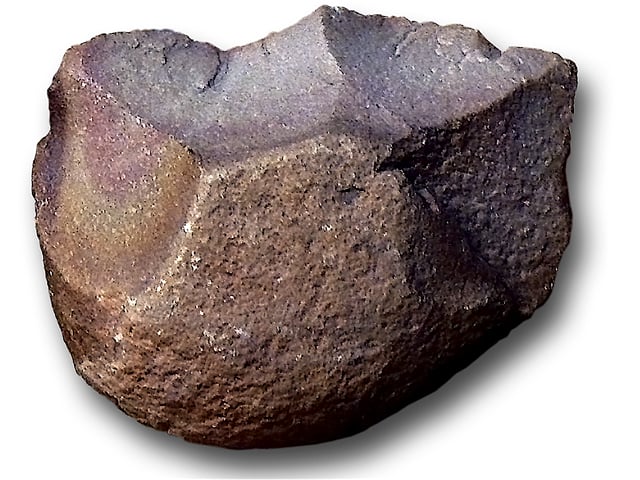
Early Homo erectus appears to have inherited Oldowan technology and refined it into the Acheulean industry beginning 1.7 million years ago.[73]
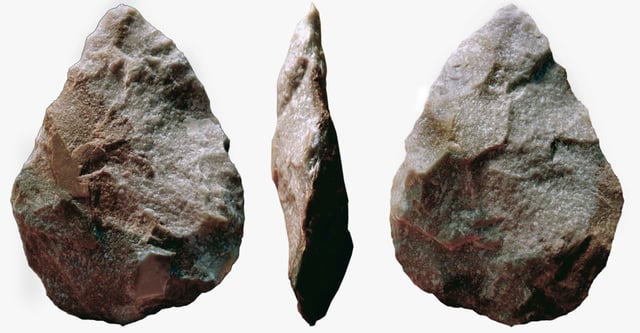
A cordiform biface as commonly found in the Acheulean, associated with Homo erectus and derived species such as Homo heidelbergensis.
The Paleolithic Age (Old Stone Age) of prehistoric human history and industry is dated from 2.6 million years ago to about 10,000 years ago;[74] thus it closely coincides with the Pleistocene epoch of geologic time, which is 2.58 million to 11,700 years ago.[75] The beginning of early human evolution reaches back to the earliest innovations of primitive technology and tool culture. H. erectus were the first to use fire to cook and to make hand axes out of stone.
Homo ergaster used more diverse and sophisticated stone tools than its predecessors, where early Homo erectus used comparatively primitive tools. This is probably because H. ergaster inherited, used, and created tools first of Oldowan technology and later advanced the technology to the Acheulean.[76] Because the use of Acheulean tools began ca. 1.8 million years ago,[77] and the line of H. erectus diverged some 200,000 years before the general innovation of Acheulean industry in Africa, then it is plausible that the Asian migratory descendants of H. erectus made no use of Acheulean technology. It has been suggested that the Asian H. erectus may have been the first humans to use rafts to travel over bodies of water, including oceans.[78] And the oldest stone tool found in Turkey reveals that hominins passed through the Anatolian gateway from western Asia to Europe approximately 1.2 million years ago—much earlier than previously thought.[79]
Use of fire
East African sites, such as Chesowanja near Lake Baringo, Koobi Fora, and Olorgesailie in Kenya, show potential evidence that fire was utilized by early humans. At Chesowanja, archaeologists found fire-hardened clay fragments, dated to 1.42 M.Y.A.[80] Analysis showed that, in order to harden it, the clay must have been heated to about 400 °C (752 °F). At Koobi Fora, two sites show evidence of control of fire by Homo erectus at about 1.5 M.Y.A., with reddening of sediment associated with heating the material to 200–400 degrees Celsius (392–752 degrees Fahrenheit).[80] At a "hearth-like depression" at a site in Olorgesailie, Kenya, some microscopic charcoal was found—but that could have resulted from natural brush fires.[80]
In Gadeb, Ethiopia, fragments of welded tuff that appeared to have been burned, or scorched, were found alongside H. erectus–created Acheulean artifacts; but such re-firing of the rocks may have been caused by local volcanic activity.[80] In the Middle Awash River Valley, cone-shaped depressions of reddish clay were found that could have been created only by temperatures of 200 °C (392 °F) or greater. These features are thought to be burnt tree stumps such that the fire was likely away from a habitation site.[80] Burnt stones are found in the Awash Valley, but naturally burnt (volcanic) welded tuff is also found in the area.
A site at Bnot Ya'akov Bridge, Israel is reported to show evidence that H. erectus or H. ergaster controlled fire there between 790,000 and 690,000 years ago;[81] to date this claim has been widely accepted. Some evidence is found that H. erectus was controlling fire less than 250,000 years ago. Evidence also exists that H. erectus were cooking their food as early as 500,000 years ago.[82] Re-analysis of burnt bone fragments and plant ashes from the Wonderwerk Cave, South Africa, has been dubbed evidence supporting human control of fire there by 1 M.Y.A.[83]
There is archaeological evidence that Homo erectus cooked their food.[82]
Engravings and religion
It has previously been thought that engraving is indicative of modern cognition and behavior.[86] In the Dubois collection discovered by Eugène Dubois in 1891, a shell with a geometric engraving was found.[87][86][88] The engraving of the shell was dated back to a maximum age of 0.5460 ± .10 million years and a minimum age of 0.4360 ± .05 million years. It was made around the time Homo erectus was present and is the oldest geometric engraving found.[86][89][90] This shows that engraved patterns were a part of the Asian Homo erectus' cognition and neuromotor control.[86]
There is very little evidence for religion among Homo erectus, though there is a possibility of it.[91] Due to the span of time, most religious artifacts would not have survived; however, as their descendants, Homo naledi and Homo neanderthalensis/sapiens, have religious or pre-religious behavior, it is feasible that this species had it as well.
Sociality
Homo erectus was probably the first hominin to live in a hunter-gatherer society, and anthropologists such as Richard Leakey believe that erectus was socially more like modern humans than the more Australopithecus-like species before it. Likewise, increased cranial capacity generally coincides with the more sophisticated tools occasionally found with fossils.
The discovery of Turkana boy (H. ergaster) in 1984 evidenced that, despite its Homo sapiens-like anatomy, ergaster may not have been capable of producing sounds comparable to modern human speech. It likely communicated in a proto-language lacking the fully developed structure of modern human language but more developed than the non-verbal communication used by chimpanzees.[92] This inference is challenged by the find in Dmanisi, Georgia, of an H. ergaster / erectus vertebrae (at least 150,000 years earlier than the Turkana Boy) that reflects vocal capabilities within the range of H. sapiens.[45] Both brain size and the presence of the Broca's area also support the use of articulate language.[93]
H. erectus was probably the first hominin to live in small, familiar band-societies similar to modern hunter-gatherer band-societies,[94] and is thought to be the first hominin species to hunt in coordinated groups, to use complex tools, and to care for infirm or weak companions. It is also unknown if they wore clothes and had tools such as bowls and utensils, however it is likely they did as they migrated to the colder regions of Asia and Europe and would have needed to carry tools, food, and water.
Descendants and subspecies
Homo erectus is the most, or one of the most, long-lived species of Homo, having existed well over one million years and perhaps over two million years; by contrast, Homo sapiens emerged about a quarter million years ago. If considering Homo erectus in its strict sense (that is, as referring to only the Asian variety) no consensus has been reached as to whether it is ancestral to H. sapiens or any later human species.
Homo erectus
Homo erectus bilzingslebenensis (0.37 Ma)
Homo erectus erectus (Java Man, 1.6–0.5 Ma)
Homo erectus ergaster (1.9–1.4 Ma)
Homo erectus georgicus (1.8–1.6 Ma)
Homo erectus heidelbergensis (0.7–0.3 Ma), now mostly treated as a derived species, H. heidelbergensis.[95]
Homo erectus lantianensis (Lantian Man, 1.6 Ma)
Homo erectus nankinensis (Nanjing Man, 0.6 Ma)
Homo erectus palaeojavanicus (Meganthropus, 1.4–0.9 Ma)
Homo erectus pekinensis (Peking Man, 0.7 Ma)
Homo erectus soloensis (Solo Man, 0.25–0.075 Ma)[96]
Homo erectus tautavelensis (Tautavel Man, 0.45 Ma)
Homo erectus yuanmouensis (Yuanmou Man)
"Wushan Man" was proposed as Homo erectus wushanensis, but is now thought to be based upon fossilized fragments of an extinct non-hominin ape.[97]
Related species
Regarding many archaic humans, there is no definite consensus as to whether they should be classified as subspecies of H. erectus or H. sapiens or as separate species.
African H. erectus candidates Homo ergaster ("African H. erectus") Homo naledi (or H. e. naledi)
Eurasian H. erectus candidates: Homo antecessor (or H. e. antecessor) Homo heidelbergensis (or H. e. heidelbergensis) Homo cepranensis (or H. e. cepranensis)
Homo floresiensis [98]
Homo sapiens candidates Homo neanderthalensis (or H. s. neanderthalensis) Homo denisova (or H. s. denisova or Homo sp. Altai, and Homo sapiens subsp. Denisova) Homo rhodesiensis (or H. s. rhodensis) Homo heidelbergensis (or H. s. heidelbergensis) Homo sapiens idaltu the Narmada fossil, discovered in 1982 in Madhya Pradesh, India, was at first suggested as H. erectus (Homo erectus narmadensis) but later recognized as H. sapiens.[99]
Fossils
The lower cave of the Zhoukoudian cave, China, is one of the most important archaeological sites worldwide.[100] There have been remains of 45 homo erectus individuals found and thousands of tools recovered.[100] Most of these remains were lost during World War 2, with the exception of two postcranial elements that were rediscovered in China in 1951 and four human teeth from 'Dragon Bone Hill'.[100]
Individual fossils
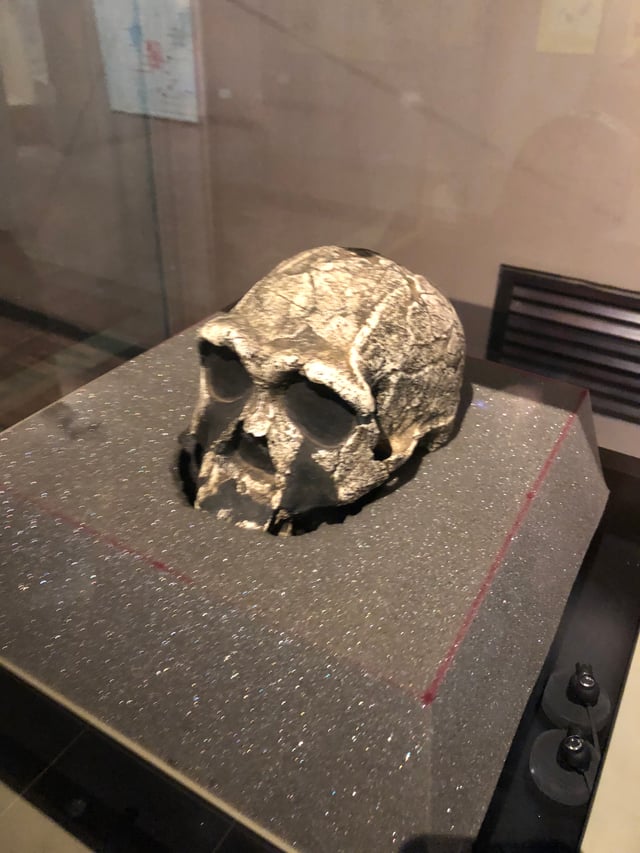
Homo erectus KNM ER 3733 actual skull
Some of the major Homo erectus fossils:
Indonesia (island of Java): Trinil 2 (holotype), Sangiran collection, Sambungmachan collection,[102] Ngandong collection
China ("Peking Man"): Lantian (Gongwangling and Chenjiawo), Yunxian, Zhoukoudian, Nanjing, Hexian
Kenya: KNM ER 3883, KNM ER 3733
